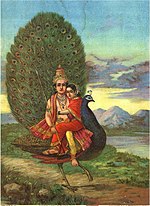Vel
| Vel | |
|---|---|
 Murugan statue with Vel at Batu Caves, Malaysia | |
| Type | Spear |
| Place of origin | India |
| Service history | |
| Used by | Murugan |
| Production history | |
| Designer | Given to Murugan by Parvati (mother) |
Vel (Tamil: வேல், lit. 'Vēl') is a divine spear associated with Murugan, the Hindu god of war.[1]
Significance[edit]
According to Shaiva tradition, the goddess Parvati presented the Vel to her son Murugan, as an embodiment of her shakti, in order to vanquish the asura Surapadman. According to the Skanda Purana, in the war between Murugan and Surapadman, Murugan used the vel to defeat all the forces of Surapadman.[2] When a complete defeat for Surapadman was imminent, the asura transformed himself into a huge mango tree to evade detection by Murugan. Not fooled by asura's trick, Murugan hurled his vel and split the mango tree into two halves, one becoming a rooster (Tamil: சேவல், lit. 'Cēval'), and the other a peacock (Tamil: மயில், lit. 'Mayil'). Henceforth, the peacock became his vahana or mount, and the rooster became the emblem on his battle flag.[3]
| Part of a series on |
| Shaivism |
|---|
 |
|
|
Vel, as a symbol of divinity, is an object of worship in the temples dedicated to Murugan. The annual Thaipusam festival celebrates the occasion when Murugan received the divine vel from his mother.[4] During this festival, some of the devotees pierce their skin, tongue or cheeks with vel skewers while they undertake a procession towards the Murugan temple.
Adi-vel is a major festival observed in Sri Lanka by Tamil Hindus in the month of July/August, known as Adi.[5] The festival take place cities such as Katharagama and Colombo.[6]
The alternative interpretation of vel is that it is a symbol of wisdom/knowledge. It symbolically shows that wisdom/knowledge should be sharp as in the vel's tip, as broad and tall as the javelin. Only such wisdom is supposed to be able to destroy the darkness of ignorance.[7]
Gallery[edit]
-
Stone vel from the Sangam period, Saluvankuppam, Tamil Nadu
-
Vel, used to worship in temple
-
Statue of Murugan with Vel
-
Coin of the Yaudheyas 200 BC, depicting Murugan with the Vel.
| Part of the series on |
| Kaumaram |
|---|
 |
See also[edit]
References[edit]
- ^ Jackson, Frances Kozlowski and Chris (August 2013). Driven by the Divine. Balboa Press. p. 143. ISBN 978-1-4525-7892-7.
- ^ Belle, Carl Vadivella (2018-02-14). Thaipusam in Malaysia. Flipside Digital Content Company Inc. ISBN 978-981-4786-66-9.
- ^ Krishna, Nanditha (2014-05-01). Sacred Animals of India. Penguin UK. p. 271. ISBN 978-81-8475-182-6.
- ^ Abram, David; Edwards, Nick (February 2004). The Rough Guide to South India. Rough Guides. p. 517. ISBN 978-1-84353-103-6.
- ^ Elliott, C. Brooke (1938). The Real Ceylon. H. W. Cave & Co. p. 133.
- ^ Tambiah, Stanley Jeyaraja (1986). Sri Lanka: Ethnic Fratricide and the Dismantling of Democracy. I.B.Tauris. ISBN 9781850430261.
- ^ Natarajan, Muni (2012-07-02). A Monk's Tale. ISBN 9780985701918.[permanent dead link]
External links[edit]




